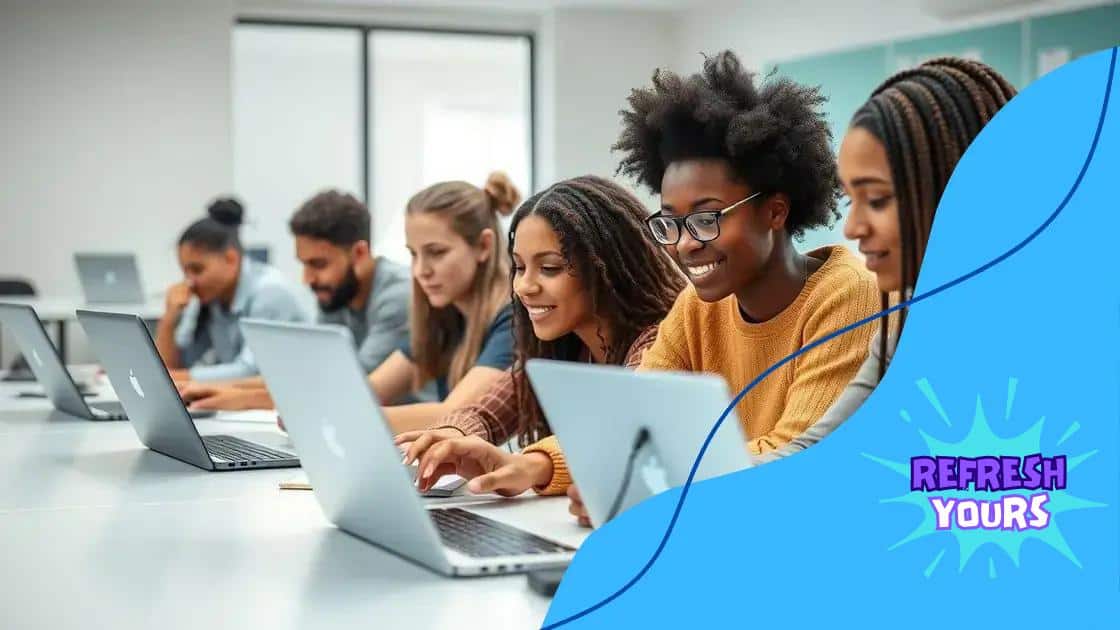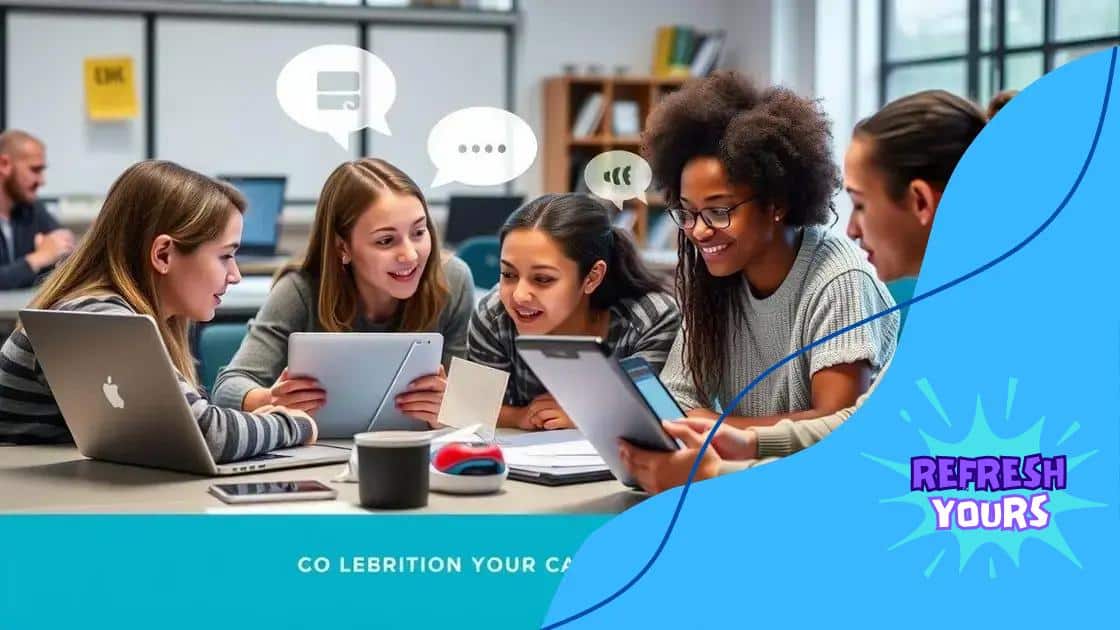How digital tools are supporting collaborative learning

Digital tools significantly enhance collaborative learning by facilitating communication, improving organization, and encouraging students to actively engage in group projects, leading to greater educational outcomes.
How digital tools are supporting collaborative learning is reshaping educational experiences. Have you noticed how technology transforms group work? Let’s explore how these tools can enhance teamwork and learning.
The role of digital platforms in collaborative learning
The role of digital platforms in collaborative learning is crucial as they foster teamwork and communication among students. The usage of these platforms brings significant changes to how groups collaborate. Imagine a classroom where technology seamlessly enhances interaction and engagement.
Benefits of Digital Platforms
Firstly, digital platforms make collaboration easier. They allow students to work together in real-time, whether in the same room or across different locations. This flexibility is essential in today’s learning environments.
- Improved communication between group members.
- Access to resources and information at any time.
- Ability to track project progress and contributions.
Moreover, these platforms can incorporate various tools such as chat functions, video conferencing, and file-sharing options. This integration helps to create an interactive and engaging learning atmosphere. It is easier for students to ask questions and share ideas when they can communicate instantly.
Examples of Digital Platforms
Some popular platforms include Google Workspace, Microsoft Teams, and Slack. Each of these tools offers unique features that support collaborative learning.
- Google Workspace: Ideal for document sharing and editing in real-time.
- Microsoft Teams: Provides a robust platform for video conferencing and integrated apps.
- Slack: Focuses on team communication with channels for different topics.
These platforms not only streamline communication but also empower students to take control of their learning experiences. By utilizing these tools, students can be more active participants in their education.
Benefits of using technology for group projects
Using technology for group projects provides several key benefits that can enhance the overall learning experience. When students collaborate through digital means, they can engage more effectively and access a wider range of resources.
Enhanced Collaboration
Technology makes it easier for students to communicate and share ideas. It allows for real-time interaction, no matter where team members are located. This interaction encourages students to work together seamlessly.
- Instant feedback can be provided on ideas and concepts.
- Students can brainstorm in virtual spaces.
- Simple access to shared documents and files.
Additionally, using technology creates a more organized workflow. Digital tools help keep track of tasks and deadlines, which is vital for successful project completion. Students can assign roles and responsibilities easily, ensuring everyone contributes.
Access to Resources
Another important benefit is the access to various online resources. Students can gain insights from articles, videos, and tutorials that cater to their project needs. This wealth of information can lead to deeper understanding and better results.
- Use of educational platforms for research purposes.
- Access to multimedia resources that enhance learning.
- Online forums for discussion and feedback.
Moreover, technology allows for creative presentations of the group’s findings. Tools like PowerPoint or video editing software can help students present their work in engaging formats. Such presentations foster excitement and interest in their projects.
Tools that facilitate communication and interaction

Tools that facilitate communication and interaction play a vital role in collaborative learning. These digital tools allow students to connect easily and share ideas, regardless of where they are. By using the right technology, students can maximize their group projects and enhance their educational experiences.
Popular Communication Tools
There are several tools designed specifically for enhancing communication among group members. These tools streamline information exchange and make collaboration easier.
- Zoom: A video conferencing platform that allows for real-time discussions and meetings.
- Slack: A messaging app that offers channels for different topics, making it easy to organize conversations.
- Trello: A project management tool that helps teams track tasks and deadlines visually.
Using these tools helps maintain an organized approach to group projects. They allow students to focus on their tasks while ensuring that everyone is on the same page. When each member can easily share updates or ask questions, projects tend to run more smoothly.
Enhancing Interaction
These tools also enhance interaction through various features. Video calls foster face-to-face exchanges, while chat apps promote quick communication. Students can share media such as images, files, and links instantly, leading to richer discussions.
- Interactive whiteboards for brainstorming and visual planning.
- Online polls and surveys for gathering group input.
- Document collaboration for real-time editing and feedback.
Additionally, integrating tools like Google Docs can create a space where everyone contributes simultaneously. This collaboration not only makes work efficient but also encourages all members to take part and share their opinions. As a result, the group produces better outcomes and learns from one another.
Best practices for remote collaboration
Best practices for remote collaboration are essential for making group work successful, especially in today’s digital learning environment. Students need effective strategies to ensure their projects run smoothly, even when everyone is working from different locations.
Establish Clear Communication
First, clear communication is key. Teams should create a communication plan that outlines how and when members will check in. Regular updates and check-ins can help keep everyone informed of progress.
- Use video calls for face-to-face interactions.
- Set up a dedicated chat channel for quick questions.
- Schedule regular team meetings to discuss project milestones.
Additionally, it helps to provide constructive feedback during team interactions. This openness encourages students to share ideas confidently and improves collaboration.
Utilize Collaboration Tools
Another best practice is to leverage collaboration tools effectively. Programs like Google Docs, Microsoft Teams, and Trello can streamline the project management process. These tools allow group members to work together in real-time, facilitating document sharing and task tracking.
- Have all team members contribute to documents simultaneously.
- Assign tasks and set deadlines using project management software.
- Utilize shared calendars to keep track of important dates.
When students use these tools, it reduces confusion and helps maintain focus on project goals. This structured approach provides clarity, which is essential for remote teamwork.
Set Expectations and Goals
It’s also crucial to set clear expectations at the project’s start. Discuss roles, responsibilities, and deadlines so everyone knows their tasks. By having shared goals, teams can work toward common objectives without misunderstandings.
Providing specific guidelines about the work process can also improve efficiency. For example, specifying which formats to use for presentations or reports can save time and effort later. Setting these standards helps align team efforts.
Case studies of successful collaborative learning initiatives
Case studies of successful collaborative learning initiatives provide valuable insights into how effective teamwork can enhance learning outcomes. These real-life examples highlight best practices and demonstrate the power of collaboration in education.
The Project-Based Learning Model
One successful initiative is the Project-Based Learning (PBL) model, where students work on projects that have real-world applications. In this approach, students collaborate to solve problems and create products. For example, a group of high school students worked together to develop a sustainability plan for their school. They researched environmental impact, engaged with local businesses, and presented their findings to the school board.
- Encouraged critical thinking and research skills.
- Promoted community involvement and awareness.
- Improved public speaking and presentation abilities.
This project not only involved teamwork but also instilled a sense of responsibility and achievement among the students.
Technology Integration in Collaborative Learning
Another notable case study involves a middle school that implemented collaborative learning through technology. Teachers integrated tools such as Google Classroom to facilitate group assignments. Students used digital platforms to communicate, share resources, and collaborate on presentations.
- Engaged students in interactive learning.
- Promoted the use of technology in educational settings.
- Fostered a sense of accountability among team members.
As a result, students reported higher levels of motivation and a greater understanding of the subject matter.
Global Collaborative Projects
Global collaborative projects also showcase successful initiatives in education. One example is the Global Classroom Project, where students from different countries work together on a shared project. By using video conferencing and online collaboration tools, they discuss and develop ideas about global issues.
This international collaboration enhances cultural understanding and helps students develop a global perspective. It also allows them to practice language skills and learn from each other’s experiences, creating a rich tapestry of ideas and innovations.
FAQ – Frequently Asked Questions about Collaborative Learning
What is collaborative learning?
Collaborative learning is an educational approach where students work together to solve problems or complete tasks, enhancing their understanding through teamwork.
How can technology facilitate collaboration?
Technology provides tools such as video conferencing and document sharing, allowing students to communicate and work together in real-time, regardless of their location.
What are some best practices for successful collaboration?
Best practices include establishing clear communication, utilizing collaboration tools, setting expectations, and regular check-ins to keep everyone on track.
Can you give examples of successful collaborative learning initiatives?
Examples include Project-Based Learning models in schools, where students tackle real-world problems, and global projects that connect students across different countries.





